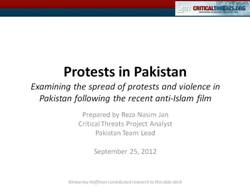{{currentView.title}}
September 25, 2012
Violence in Pakistan: Mapping the Protests Following the Anti-Islam Film
Protests and violence have erupted across the Muslim world following the release on YouTube of “Innocence of Muslims,” a film mocking the Prophet Muhammad. Nowhere has the violence been as intense as in Pakistan, where demonstrations and riots have claimed over 20 lives since street agitation first began on Friday, September 14.
 |
As protests continued throughout the week, the government of Pakistan decided to respond to public pressure by declaring a public holiday on Friday, September 21 in solidarity with the protestors. Violent protests that day subsequently spiraled out of control and became the deadliest day of protesting against the film across the Muslim world with over 20 killed and 200 wounded.
What the data and reporting on the protests make clear is that, far from being spontaneous outpourings of public anger, the protests were fueled by hard-line religious parties and militant Islamist groups. Furthermore, by completely ceding ground to the protestors the Pakistani government allowed the violence to get much worse than it otherwise might have been.
This slide deck tracks the spread of protests across Pakistan, their reach across the country, incidences of violence, and the tendency for violent protests to occur near U.S. diplomatic missions, especially in Karachi, the worst-hit city.
Kimberley Hoffman contributed research to this slide deck.
